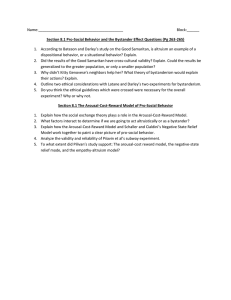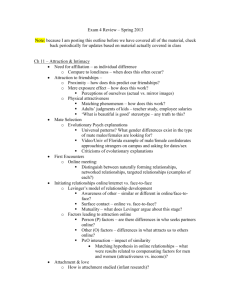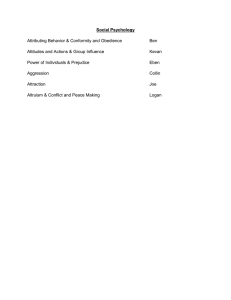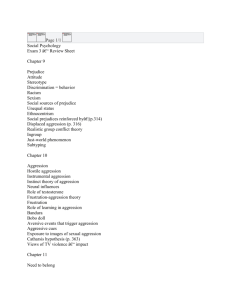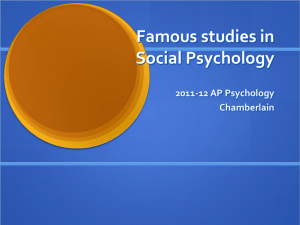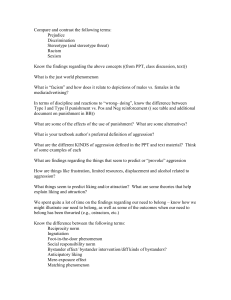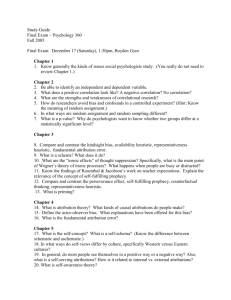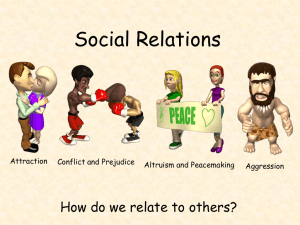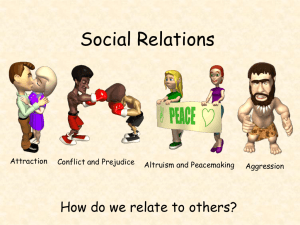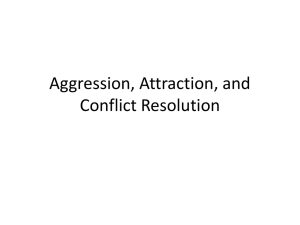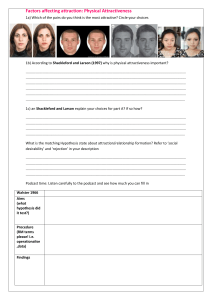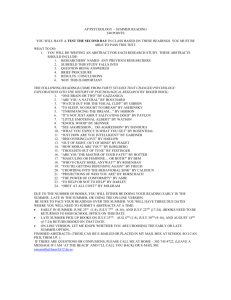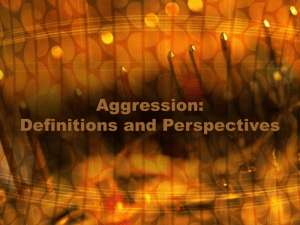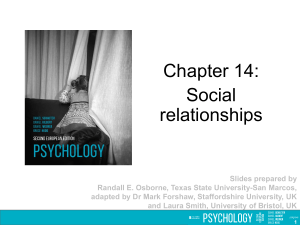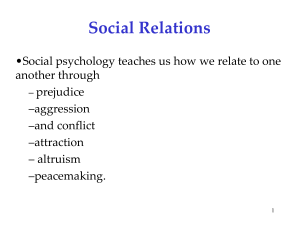Chapter 11 - Attraction - the Department of Psychology at Illinois
advertisement
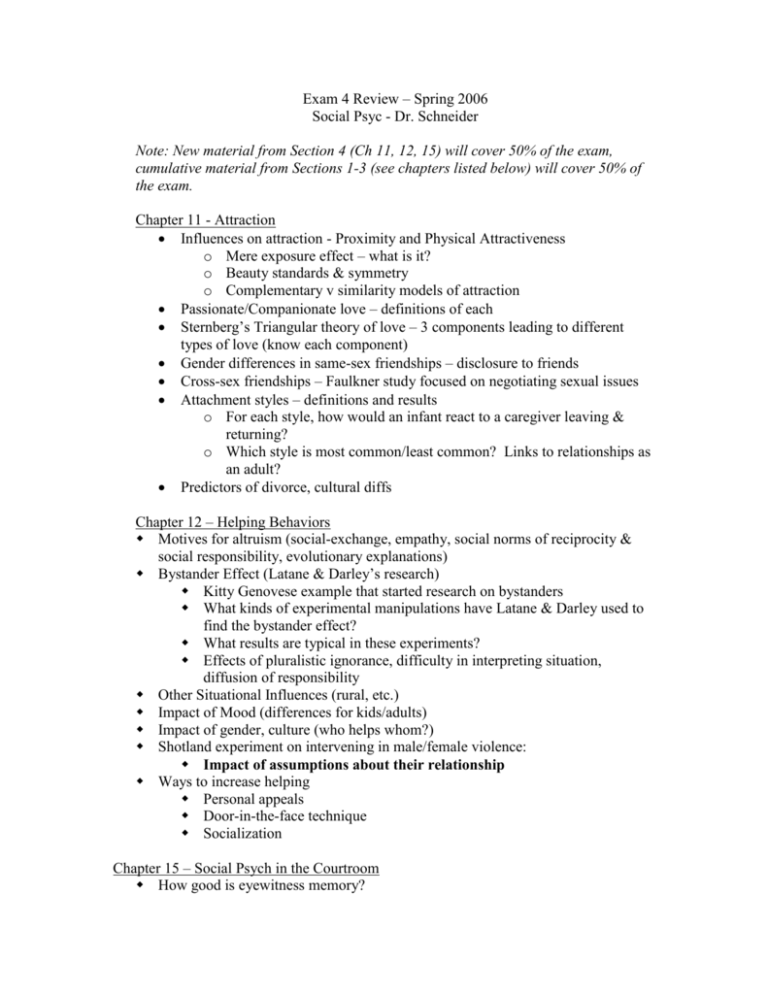
Exam 4 Review – Spring 2006 Social Psyc - Dr. Schneider Note: New material from Section 4 (Ch 11, 12, 15) will cover 50% of the exam, cumulative material from Sections 1-3 (see chapters listed below) will cover 50% of the exam. Chapter 11 - Attraction Influences on attraction - Proximity and Physical Attractiveness o Mere exposure effect – what is it? o Beauty standards & symmetry o Complementary v similarity models of attraction Passionate/Companionate love – definitions of each Sternberg’s Triangular theory of love – 3 components leading to different types of love (know each component) Gender differences in same-sex friendships – disclosure to friends Cross-sex friendships – Faulkner study focused on negotiating sexual issues Attachment styles – definitions and results o For each style, how would an infant react to a caregiver leaving & returning? o Which style is most common/least common? Links to relationships as an adult? Predictors of divorce, cultural diffs Chapter 12 – Helping Behaviors Motives for altruism (social-exchange, empathy, social norms of reciprocity & social responsibility, evolutionary explanations) Bystander Effect (Latane & Darley’s research) Kitty Genovese example that started research on bystanders What kinds of experimental manipulations have Latane & Darley used to find the bystander effect? What results are typical in these experiments? Effects of pluralistic ignorance, difficulty in interpreting situation, diffusion of responsibility Other Situational Influences (rural, etc.) Impact of Mood (differences for kids/adults) Impact of gender, culture (who helps whom?) Shotland experiment on intervening in male/female violence: Impact of assumptions about their relationship Ways to increase helping Personal appeals Door-in-the-face technique Socialization Chapter 15 – Social Psych in the Courtroom How good is eyewitness memory? – Accuracy vs. confidence Misinfo Effect – why does it occur? – What is the source monitoring error? Cognitive Interviews – what do they involve? Line-ups – how to reduce errors in ID – Gary Wells’ research on line-up problems Jennifer Thompson case (DNA tests) – from in-class video, what happened in this case? Schooler study of accurate v. inaccurate witnesses – what were the differences? Juror biases (attractiveness, similarity) Judge’s instructions (reactance) How to present info to jury Minority influence in juries / leniency 12 v 6 person juries Death penalty cases – who are qualified jurors? Criticisms of jury research Review of previous material for cumulative section: Part 1 (Ch 1-4): Identifying independent v dependent variables Random sampling definition The Influence of Culture: Collectivism vs. Individualism (definitions, examples; influence on self-esteem) Self-serving bias, False Consensus and False Uniqueness Internal/External Attributions FAE (what it is) Components of attitudes (ABC model) Link betw att & behavior Bogus pipeline – how did this work and what did it show? Impact of role playing (Stanford Prison Experiment – know the results & details of this study) Changing Attitudes – 4 theories Cognitive Dissonance – what is it? Self-presentation – influence of impression management Self-perception – facial feedback hypothesis; overjustification Self-verification – influence of positive v negative self-concept Part 2: Ch 5-7 Evolutionary Psychology - What is the basic approach to explaining behavior? Culture & Behavior - How is culture defined? What does it influence? What are universal norms across cultures? Gender Aggression and Sexuality – what are the gender differences? Androgyny – what is it? Types of conformity 3 Classic Conformity studies (Sherif, Asch, Milgram) Know the details, results, and major contributions of each Normative v informational influence of groups ELM Model: Central v Peripheral routes of Persuasion Resisting persuasion / attitude inoculation – how does this work? Subliminal messages – Greenwald’s study; Murphy’s study What were main results; how did the 2 studies differ? Part 3: Ch 8-10 Definitions of groups Social Facilitation – effects of easy v difficult task? Effects of Crowding – why others impact us (eval apprehension, distraction, mere presence of others) Social Loafing experiments – main results? Solution for this? Deindividuation – what are 2 main influences? Group Polarization and Groupthink – definitions Differences between stereotypes, prejudice, discrimination (Affective, Behavioral, Cognitive components) Subtle/Modern racism - definitions Stereotype Threat – Steele’s results Jane Elliott’s Blue-Eyed exercise 4 main causes of prejudice (Social Identity theory, Realistic Group Conflict; Authoritarian personalities; Cognition – ingroup/outgroup) Theories of Aggression: Biological explanations (testosterone, alcohol), Frustrationaggression theory, Social Learning (Bandura) - evidence for each theory? Impact of Culture of Honor – Nisbett’s research Media & violence – Gerbner’s research Aggression & porn/rape myth Catharsis hypothesis – supported or not? How punishment can be effective Baron’s research on incompatible responses to aggression – what does he find?

